Insect Pests of the Home Vegetable Garden
Control Recommendations for Traditional and Organic Gardeners
The average home vegetable gardener grows more than a dozen different types of vegetables, and each may be attacked by several different species of insects. Managing and controlling insect pests is one of the keys to successful vegetable gardening.
Insect pests can damage vegetables in many ways. Pests such as tomato fruitworms, cowpea curculios, stink bugs, and pickleworms feed on the fruit, causing direct damage. Other pests, such as loopers and tobacco hornworms, feed on the leaves, while pests like aphids, whiteflies, and mites suck sap from the plant, causing indirect damage. Even though the fruit is not damaged directly, the plant can’t efficiently produce fruit if it loses too much leaf area or sap. Pests such as thrips and bean leaf beetles transmit plant diseases, and pests like corn earworms and cowpea curculios cause damage by contaminating food with their frass and bodies.
Even though many different species of mite and insect pests can occur in the home vegetable garden, they do not usually occur all at one time, and you don’t have to spend the summer spraying for bugs to have a successful garden. You can use many methods other than insecticide sprays to manage insects and keep them from reaching damaging levels. Many of these methods are passive, requiring relatively little effort on the part of the gardener, and many must be done anyway to grow a vigorous, productive crop.
Sometimes insect pest populations do reach damaging levels, and treatment with insecticides becomes necessary. But you can make such treatments just to the crop being attacked. It is rarely necessary and is often counterproductive to apply a broadcast treatment of insecticide to every crop in the garden. Unnecessary insecticide treatments can cause pest problems that would not have occurred otherwise by destroying beneficial insects, allowing the pests they were keeping in check to increase in numbers.
In some situations, you may have to apply insecticide repeatedly to protect certain crops. This is especially likely when you try to produce a crop at a certain time of year or in a location where pest populations are especially high. For example, yellow squash are very likely to experience heavy infestations of squash bugs and squash vine borers when you grow them in midsummer to fall. When you grow Southern peas in the same location year after year, they are likely to experience heavy infestations of cowpea curculios unless you make timely insecticide treatments. Fall tomatoes normally experience heavy infestations of stink bugs, leaf footed bugs, and tomato fruitworms. There are many other examples. Experienced gardeners quickly learn which pests are especially troublesome in their area and when to expect these pests.
Noninsecticidal Insect Management Methods
Biological Control
Biological control is the most important method to control insect pests. Many different predators and parasites feed on insect pests and help keep populations in check. If we didn’t have these natural predators and parasites, our gardens would be overrun with insect pests. Nature provides these predators and parasites as free insect control. The gardener has only to recognize the importance of biological control and avoid disrupting it when possible.
By their very nature, insecticide treatments disrupt biological control because they kill beneficial insects as well as pests. This is why it is important to avoid making unnecessary insecticide treatments. By destroying naturally occurring beneficial insects, insecticide treatments can actually cause pest populations to increase. But don’t let fear of disrupting natural control prevent you from making insecticide applications when they really are needed.
In the Southern garden, there will be times when pest populations escape natural control and reach damaging levels. Prompt, wise use of insecticides can control pest populations and help prevent crop damage.
When selecting insecticide treatments, keep in mind that some insecticides disrupt natural control more than others. For example, Bt products control only caterpillar pests and don’t harm most beneficial insects. But broad-spectrum insecticides, such as permethrin, are more disruptive. Still, sometimes you will have to use one of the broad-spectrum treatments to control a certain pest or pest complex.
Cultural Control
Cultural practices can affect plants’ susceptibility to insect injury. Healthy, vigorous plants are generally more resistant and more tolerant to insect damage, so practices that promote good growth and plant health also aid in insect management. Early-planted crops usually have fewer insect problems than late-planted crops because many insect pests complete several generations per growing season, producing more insects with each generation. This is especially important with crops such as sweet corn, summer squash, and tomatoes. Good sanitation practices, such as weed control and prompt removal of nonproductive plants, help reduce insect populations.
Some vegetable varieties are less susceptible to insect damage than other varieties of the same vegetable, so variety selection is also important.
Mechanical Control
Hand-picking and foot-stomping are examples of mechanical controls home gardeners can use. In small plantings, hand-removing individual insects or egg masses can be a useful way to control insects. Washing aphids from plant terminals with spray from a garden hose is another form of mechanical control. Another example is floating row covers, which keep insects from being able to attack or deposit eggs on young plants. Collars of waxed paper or aluminum foil protect young transplants from cutworm attack.
Reflective mulches are another useful mechanical control for certain pests. They are especially effective in preventing thrips from attacking young tomato and pepper plants and spreading virus diseases, particularly tomato spotted wilt virus. Plastic mulches, rather than organic mulches, help reduce populations of certain pests because the plastic mulch discourages pests such as crickets and slugs. Commercially available pheromone traps or sticky traps can also help control or monitor certain pest species.
Common Insect Pests of the Home Vegetable Garden
The following information covers the most common insect pests found in Southern vegetable gardens. The crops most frequently attacked by the pest are listed after the pest name. Noninsecticidal management practices are briefly discussed under “Management Practices,” and some of the more common insecticides that are effective against the pest are listed under “Control.” Comments on timing of insecticide treatments and methods of application are also included under “Control.” Note, though, that these insecticides are not necessarily labeled for use on all vegetable crops. Before applying any insecticide to a specific vegetable crop, check the label to see if the insecticide is labeled for use on that particular crop. See the insecticide recommendation table at the end of this publication for specific crop/pest control recommendations. Insecticides marked with an asterisk (*) may be acceptable for organic gardening. Note that the order in which insecticides are listed does not indicate how well they work.
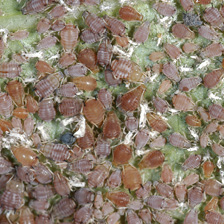
APHIDS: attack most garden vegetables.
Aphids are small, soft-bodied insects with piercing-sucking mouthparts. There are many different species, and color can vary from green to red, pink, or black. Beneficial insects and diseases usually control aphids, but they reproduce rapidly and can build to very high numbers quickly. Aphids remove plant sap and kill developing plant cells. They also carry many diseases. Heavy infestations can cause leaf curl, yellowing, poor growth, and failure to set blooms. Aphids also excrete large amounts of undigested plant sap (honeydew). This sugary liquid builds up on leaves, where it supports the growth of sooty mold fungi. Although sooty mold does not invade plant tissue, the black, crusty mat it produces on the surface of the leaf is unsightly and can reduce photosynthesis.
Management Practices: Avoid unnecessary insecticide use because it can disrupt natural control. Use water spray from a garden hose to dislodge isolated concentrations of aphids.
Control: azadirachtin*, acetamiprid, insecticidal soap*, neem oil*, malathion
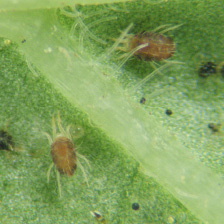
SPIDER MITES: attack most garden vegetables, especially cucumbers, other cucurbits, beans, tomatoes, and eggplant.
Spider mites are not insects but belong to a closely related group. There are several different species, all of which are so small that individuals are difficult to see. Natural controls usually keep spider mite populations in check, but spider mites reproduce quickly, and outbreaks can occur. Mites feed on individual plant cells with their sucking mouthparts, usually on the undersides of leaves. Single mites don’t cause a lot of damage, but heavy populations can cause serious injury. Severely injured leaves often look stippled, and webbing usually indicates a severe infestation.
Management Practices: Avoid unnecessary insecticide use, which can disrupt natural control. Keep plants properly watered. Drought stress can favor spider mite infestations, and drought-stressed plants are less able to tolerate mite injury.
Control: insecticidal soap*, neem oil*
Currently no specific miticides are labeled for use on most vegetables grown in the home garden. Spider mites can be very difficult to control. If you try to control spider mites with foliar insecticide sprays, be sure to get thorough coverage, especially on undersides of leaves, and treat at least twice, at 4- to 5-day intervals.
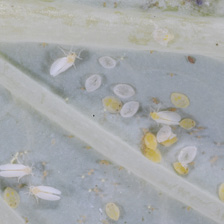
WHITEFLIES: attack tomatoes, peppers, eggplant, okra, cucumbers, other cucurbits, brassicas, and other vegetables
Adult whiteflies are approximately the size of aphids and have white, moth-like wings. Immature whiteflies are immobile and scale-like. They feed on the undersides of leaves. Both adults and immatures have piercing-sucking mouthparts and cause damage by removing plant sap, producing honeydew, and transmitting diseases. There are several species; silverleaf whitefly can be especially difficult to control.
Management Practices: Avoid unnecessary insecticide use, which can disrupt natural control. It is better not to spray than to spray with the wrong insecticide. Insecticides such as malathion, Sevin, permethrin, or other pyrethroids will flare or stimulate whitefly populations.
Control: azadirachtin*, acetamiprid, insecticidal soap*, neem oil*
Make two to three sprays at 5- to 7-day intervals. Acetamiprid is the most effective foliar spray for whiteflies. Imidacloprid applied as a soil drench to transplants or young seedlings is a useful preventive treatment for gardens with a history of whitefly problems.
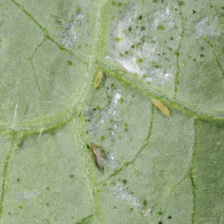
THRIPS: attack tomatoes, peppers, and watermelons.
Thrips are tiny insects, less than one-sixteenth of an inch long, that feed on plant leaves and fruit with “punch-and-lap”-type mouthparts. Several species of thrips occur in the home garden. One species, the western flower thrips, is the main carrier of tomato spotted wilt virus. Thrips can also distort leaf growth (especially on watermelon seedlings) and cause fruit blemishes (especially on tomatoes and peppers).Thrips occur on most garden vegetables, but greatest damage occurs on watermelons, tomatoes, and peppers. Thrips infestations tend to be especially heavy in dry springs.
Management Practices: Use reflective mulches under tomato and pepper plants. Thrips are less attracted to plants grown over reflective mulches, reducing transmission of tomato spotted wilt virus. Planting some tomato varieties that are resistant to tomato spotted wilt virus increases your chances of making tomatoes, even in years when thrips/tomato spotted wilt virus infestations are heavy.
Control: insecticidal soap*, neem oil*, spinosad*, permethrin, bifenthrin, malathion, acetamiprid, zetamethrin
Note: Because infected thrips can transmit tomato spotted wilt virus as soon as they begin feeding on the plant, controlling thrips with insecticide sprays is not very effective in preventing tomato spotted wilt virus. The insecticide may kill the thrips, but not before they have had a chance to transmit the virus. Reflective mulches are more effective because they reduce the number of thrips that alight on plants and try to feed.
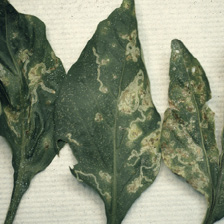
LEAF MINERS: attack tomatoes, cucumbers, beans, and peas.
Adult serpentine leaf miners are small (less than one-sixteenth of an inch), dark-colored flies with yellow markings. The larvae are small, peg-shaped, legless maggots that feed between the upper and lower surface of leaves, creating winding tunnels, or mines. The mines, which are very narrow when the larva first hatches, become wider as the larva grows. Mature larvae exit the leaf and fall to the ground to pupate. Low numbers of mines cause no real damage to the plant, but heavy, persistent infestations can reduce leaf area, resulting in reduced plant vigor. Serious infestations occur most commonly on tomatoes; even so, it is rather uncommon for field-grown tomatoes to require treatment. Heavy infestations occasionally occur on cucumbers, beans, or Southern peas.
Management Practices: Predators and parasites usually control leaf miners. Avoid unnecessary insecticide use, which can disrupt natural control.
Control: spinosad*
To control severe infestations, make multiple applications at 3- to 5-day intervals.
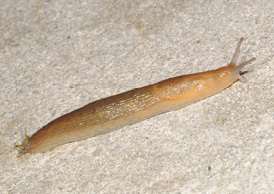
SLUGS: attack lettuce, cabbage, and other vegetables.
Slugs are not insects; they are mollusks. These shell-less relatives of snails cause damage by feeding on leaves and other plant parts with their rasping mouthparts. Because their soft bodies are subject to drying out, they tend to hide under plant debris during the day and move about only at night, leaving dried mucus trails. Slugs feed on a variety of plants, but they normally cause greatest concern on plants grown for their leaves, such as leaf lettuce.
Management Practices: Thorough tillage to cover old plant residue reduces harborage sites for slugs. Organic mulches provide conditions that are favorable to slugs. In small-scale plantings, traps baited with beer can aid in control.
Control: metaldehyde, iron phosphate
Apply baits containing metaldehyde or iron phosphate to the soil around vegetables. Do not apply to edible plant parts. When treating slugs in raised beds, apply baits around the outside of the bed. Don’t wait for heavy infestations to develop—treat preventively.

ANTS: attack okra, potatoes, and gardeners.
Fire ants are the ant species most common in Mississippi gardens. Besides their stings, which interfere with tending and harvesting the garden, fire ants also damage some vegetables, such as okra and Irish potatoes. Sometimes fire ants reduce stands of corn and other crops by eating the germ of newly planted seed. Fire ants nest in mounds, which may be within the garden, or foraging workers may enter the garden from mounds around the outside of the garden.
Management Practices: Granular baits are effective fire ant control tools but are slow-acting. Most of the fire ant baits labeled for use on home lawns may not be applied directly in the garden area. But you can apply labeled fire ant baits to the lawn area immediately surrounding the garden to help reduce the number of ants that invade the garden. For best results, treat two to three times per year, in early spring, midsummer, and/or fall. Some fire ant baits containing the active ingredient spinosad may be applied directly to the garden and are even approved for use by organic gardeners.
Control: spinosad*, permethrin, carbaryl
You can control problem mounds within the garden area by drenching with one of the listed insecticides. Mix and apply according to directions on the label. Use 1 to 2 gallons of drench per mound.
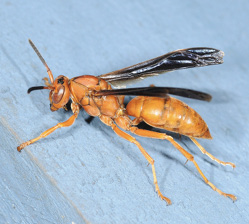
BEES AND WASPS: benefit the home vegetable garden.
Many different species of bees and wasps occur in the home garden. These include social species, such as paper wasps, honeybees, bumblebees, and several solitary species. These insects are very beneficial. Bees pollinate vegetable crops, and paper wasps prey on caterpillars and other soft-bodied insects, which they carry back to the nest and feed to their young. However, some people are intimidated by the large number of stinging insects that are often present in a garden. Although social bees and wasps can be very aggressive when defending their nests, they are not aggressive when foraging for pollen or prey away from the nest, and unprovoked attacks rarely occur. Most stings in the home garden occur when a bee or wasp becomes trapped in clothing or entangled in hair or is accidentally grasped while picking vegetables.
Management Practices: Schedule gardening activities early or late in the day when foraging bees and wasps are less active. Wear a hat or keep hair tied up to reduce chances of stinging insects getting in your hair. Avoid brightly colored clothing, which attracts some bees and wasps. Avoid using perfumes or other scented cosmetics that can attract bees and wasps. Anyone who is hypersensitive to stings should take appropriate precautions as advised by a physician.
Control: Occasionally, paper wasps build nests in garden locations, such as in vegetable trellises, where they are likely to cause problems. Control such problem nests with aerosol wasp sprays.
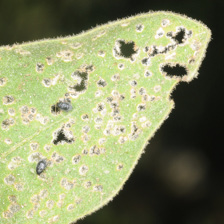
FLEA BEETLES: attack eggplant, tomatoes, peppers, potatoes, sweet potatoes, cucumbers, and other vegetables.
Flea beetles are very small beetles that jump vigorously when disturbed. There are several species, and color may range from black or brown to striped. Damage is caused by adult beetles, which feed on the leaves and cause tiny shot-holes, and by larvae, which feed on roots in the soil. Large numbers of adults can destroy newly set transplants of sensitive species, such as eggplant and sweet potatoes, and heavy feeding on larger plants can cause severe shot-holing, which can greatly reduce plant vigor and productivity. Larvae can severely injure root crops, such as Irish potatoes and sweet potatoes, by feeding on the outer surface of the tuber and causing tracks or scars. Flea beetles can also transmit certain plant diseases.
Management Practices: Control horse nettle and other weed species that serve as alternate hosts for flea beetles in and around the garden. Keep the garden tilled or mulched when not in production. Use row covers to keep out adults.
Control: permethrin, bifenthrin, malathion, zetamethrin
Use foliar sprays as needed to control adult flea beetles. Treat especially susceptible species, such as eggplant, immediately after transplanting. Soil drench treatment with imidacloprid, applied at planting or immediately after planting, will help prevent flea beetle damage on especially susceptible crops, such as eggplant, turnips, mustard, and other brassicas, but note the 21-day pre-harvest interval.
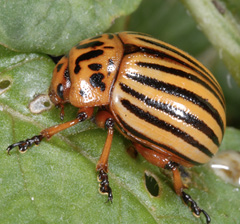
COLORADO POTATO BEETLE: attack Irish potatoes, eggplant, tomatoes, and peppers.
The round, convex shape and black and tan stripes of the adult Colorado potato beetle give it a distinctive appearance. The larvae, which are reddish-orange with black markings, are also distinctive. Both the adults and larvae feed on the leaves, and heavy infestations can cause severe defoliation, especially to their favorite host, Irish potatoes. The clusters of oblong, yellow eggs are attached to the leaves.
Management Practices: Control horse nettle and other weed species in and around the garden. These weeds can host Colorado potato beetles. Use row covers to keep out adults. Hand-pick individual beetles, larvae, and egg masses.
Control: spinosad*, permethrin, acetamiprid, zetamethrin
Eggplant, tomatoes, and peppers are most susceptible when small. Check new transplants frequently and treat promptly when necessary.
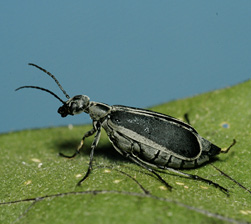
BLISTER BEETLES: attack tomatoes, potatoes, beans, and other vegetables.
Immature blister beetles are beneficial because they feed on grasshopper eggs and other insects. But the adults are leaf-feeders, and they occasionally occur on tomatoes and other vegetable crops. Because adult blister beetles often congregate and move about in large groups, individual plants can be severely defoliated quickly. Adults have an elongated body and are about one-half to three-fourths of an inch long. There are several species of blister beetles. Some are black, or black with gray margins, while others are yellow- and brown-striped. As their name implies, blister beetles can cause severe skin irritation if handled.
Management Practices: Sometimes you can control low numbers by dislodging them from plants and stomping on them, but do not directly handle blister beetles.
Control: permethrin, bifenthrin, zetamethrin
Spot-spray concentrations of adult beetles.
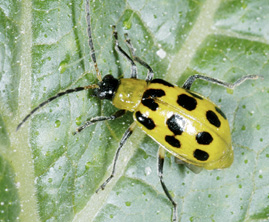
CUCUMBER BEETLES: attack cucumbers, melons, other cucurbits, beans, Southern peas, and corn.
Three species of cucumber beetles occur in Mississippi gardens. The striped cucumber beetle has black and yellow stripes and feeds mostly on cucumbers, melons, and squash. The 12-spotted cucumber beetle, which is yellow with black spots, feeds on all of these cucurbits, as well as on beans, peas, and corn. Banded cucumber beetles, which occur mainly in the southern portion of the state, are green with bright yellow spots. They have a host range similar to the 12-spotted cucumber beetle and can be a major pest on sweet potatoes. Adults of all three species are approximately three-sixteenths of an inch long and feed on leaves, while larvae feed on roots in the soil. Damage potential is greatest on emerging seedlings. Adults can destroy germinating melon, squash, and cucumber seedlings before they fully emerge. Plants taller than 6 inches are less likely to be killed, but heavy defoliation can still reduce plant vigor. Larvae of the 12-spotted cucumber beetle, also known as the southern corn rootworm, can also destroy young corn seedlings. Adults may feed on the corn silks, causing “skippy” ears. Adult cucumber beetles may also feed on and scar the surfaces of squash, pumpkins, and melons. Cucumber beetles can carry a number of plant diseases.
Management Practices: Use row covers to exclude adults from emerging seedlings.
Control: permethrin, bifenthrin, acetamiprid, zetamethrin
Check emerging seedlings frequently, and treat promptly if needed. Adult beetles may continue to arrive, resulting in the need for follow-up treatments. Soil drench treatment with imidacloprid, applied at planting or immediately after planting, will help prevent early cucumber beetle damage on young squash, pumpkins, and other cucurbits.
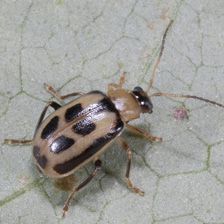
BEAN LEAF BEETLES: attack beans and Southern peas.
Adult bean leaf beetles are about three-sixteenths of an inch long and occur in a variety of colors. The most common color is beige with black borders and black spots, but individual beetles may be red with black markings, or solid beige, pink, or red. Adults feed on leaves of beans and Southern peas, while larvae feed on the roots and nitrogen-fixing nodules in the soil. Greatest damage occurs when large numbers of adults feed on very young seedlings. Occasionally the amount of defoliation can be severe enough to reduce plant vigor. Adults also feed on pods and the seed within, but this damage is rarely common enough to warrant treatment. The adults carry a number of important virus diseases of peas and beans.
Management Practices: Use row covers to exclude adults from emerging seedlings. Bean leaf beetles overwinter as adults in leaf litter. When they emerge in the spring, they are strongly attracted to the first available plantings of peas and/or beans. Controlling these overwintered adults greatly reduces the potential for problems with later generations.
Control: malathion, bifenthrin, permethrin, zetamethrin
Check emerging seedlings frequently, and treat promptly if needed. Adult beetles may continue to arrive, resulting in the need for follow-up treatments.
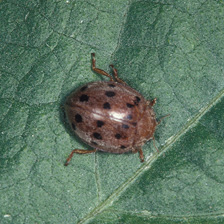
MEXICAN BEAN BEETLES: attack beans and Southern peas.
The Mexican bean beetle is one of the few species of lady beetles that feed on plants. Adults are copper colored and have 16 small, black spots. The larvae are yellow but are covered with black-tipped spines. The long, yellow eggs are attached to the leaves in small clusters. Both the adults and larvae feed on the leaves. These beetles prefer lima beans and snap beans more than peas. The squash beetle, a related species, sometimes occurs on squash and other cucurbits.
Management Practices: Infestations of Mexican bean beetles are rare, and treatment is rarely required. Use row covers to exclude adults from emerging seedlings. If numbers are low, hand-picking eggs, larvae, and/or adults can be helpful.
Control: malathion, bifenthrin, zetamethrin

COWPEA CURCULIOS: attack Southern peas and occasionally beans.
This insect causes small circular spots on the seeds of Southern peas. These are egg-laying punctures. The small, legless grubs develop inside the individual peas. Sometimes you see these larvae when you shell peas, especially more mature peas. The adults are dark gray and about three-sixteenths of an inch long, but you rarely see them because they quickly drop to the ground when disturbed. This insect rarely flies. Adults overwinter in nearby ground trash and crawl into the garden in the spring.
Management Practices: Because the adults rarely fly, moving the garden site, or at least the pea patch, can help reduce infestation levels. New sites should be at least a few hundred feet from old sites. But this insect has a number of weed hosts, and site rotation is not effective when there are lots of alternate hosts. Destroying pea vines promptly after the last harvest prevents many insects from completing development.
Control: bifenthrin, zetamethrin
Begin treatment when small pea pods first appear (about a half-inch long). Make three applications at 5-day intervals. It is important to begin treatments before pods are large enough to support egg-laying.
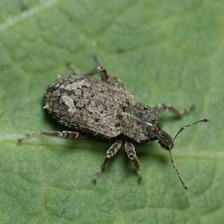
VEGETABLE WEEVILS: attack turnips, mustard, bok choy, and other brassicas, as well as tomatoes, potatoes, and other vegetables.
Adult vegetable weevils are stout-bodied, grayish-brown beetles with short, stout snouts. They are about five-sixteenths of an inch long and usually have a distinct, light-colored “V” on their backs. The legless larvae are greenish-yellow and are found crawling about on leaves and in plant crowns. Pupation occurs in the soil. Both adults and larvae are leaf-feeders, but they also damage stems and roots. You see this insect most commonly on turnips, where it can cause considerable damage, but it occasionally attacks other vegetables, as well. Newly transplanted tomatoes and other seedlings sometimes experience heavy damage, especially when planted in an area where turnips, mustard, or other winter brassica crops were recently growing. The adults are active from late fall through early summer, but they hibernate through the summer. Adults rarely fly. The yellowmargined leaf beetle causes similar damage to turnips, and infestations of these two beetles often occur together.
Management Practices: Adult vegetable weevils rarely fly, so rotating the garden site can help reduce infestation levels. Vegetable weevils also reproduce on a number of weed hosts. Because the pupae occur in the soil and the adults oversummer underneath crop debris, cultivation and tillage can help reduce infestation levels.
Control: malathion, zetamethrin
Pre-harvest intervals for leafy vegetables are quite long for most insecticides. Apply treatments well before harvest to prevent damage and to meet required pre-harvest intervals.
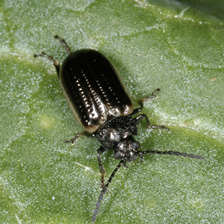
YELLOWMARGINED LEAF BEETLES: attack turnips, mustard, bok choy, and other brassicas.
Yellowmargined leaf beetles usually occur in combination with vegetable weevils. Adults are small, black beetles, about one-quarter inch long, with a pale yellow margin around the outer edge of the body. Larvae are small, black insects with a body shape similar to the larvae of Colorado potato beetles. Damage is caused by adults and larvae feeding on leaves, resulting in defoliation injury. Like vegetable weevils, yellowmargined leaf beetles are active during the cooler months of the year—fall through late spring.
Management Practices: Destroy stands of brassica plants as soon as possible after final harvest. This practice is especially helpful because it prevents insects from developing into adults and moving to other crops or entering summer aestivation.
Control: malathion, spinosad, zetamethrin
Malathion is best applied only to very young plants because of the long pre-harvest intervals. Spinosad provides good control of yellowmargined leaf beetles and has a 1-day pre-harvest interval on turnips, mustard, and most other brassicas.
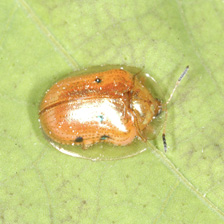
TORTOISE BEETLES: attack sweet potatoes and eggplant.
Several species of tortoise beetles may occur in the home garden. Although you may see them on other plants, they most commonly attack sweet potatoes and eggplant. Both adults and larvae are foliage feeders, usually feeding from the underside of the leaf and causing small shot-holes through the leaves. Adults of many species have a flattened margin around the edge of their bodies, giving them a distinctive, somewhat rounded shape. One species, the golden tortoise beetle, is a striking gold color. Eggplant tortoise beetles are greenish. The larvae are covered with spines and have an extended forked structure at the end of the abdomen, which becomes covered with cast skins and fecal material. This causes the larvae to look like nothing more than a bit of dried plant debris stuck to the underside of a leaf. This fork can be folded over the back or may extend straight out from the end of the abdomen.
Management Practices: Although tortoise beetles are not rare, it is uncommon for them to cause serious damage.
Control: malathion, zetamethrin
Direct spray to the undersides of leaves.
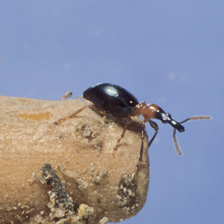
SWEET POTATO WEEVILS: attack sweet potatoes.
Adult sweet potato weevils are unique in appearance. The head and abdomen are shiny black to metallic blue, while the thorax and legs are reddish-orange. These beetles are about one-fourth of an inch long, with long legs, a slender body, and an elongated snout. The larvae are slender, white, legless grubs. Damage is caused by both the adults and larvae, which begin feeding on roots in the field and continue to feed and reproduce on roots after they are harvested and stored. Larval feeding gives a bitter taste to sweet potatoes. Infested potatoes are riddled with larvae and their frass-packed galleries. This insect is an extremely important pest of commercial sweet potatoes. It is not currently established north of the Meridian-Canton-Yazoo City area, and there is a quarantine against shipping infested sweet potatoes into the northern portion of the state. Sweet potato weevils occur on sweet potatoes as well as on certain species of morning glories in the southern portion of the state.
Management Practices: Buy and plant only certified weevil-free seed potatoes or slips. Check stored potatoes regularly, and immediately destroy all potatoes if you find sweet potato weevils. Destroy infested potatoes in a way that will kill adult weevils and larvae. Do not simply discard infested potatoes. Contact the Mississippi Department of Agriculture immediately if you detect sweet potato weevils north of Highway 16.
Control: bifenthrin (preharvest interval = 21 days)
Where sweet potato weevils are present, you may have to make repeated weekly or biweekly sprays to prevent damaging infestations. You can use commercially available pheromone traps to monitor for the presence of adult sweet potato weevils and thus determine the need for treatment.
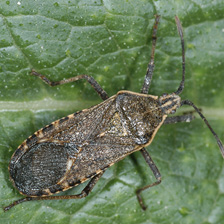
SQUASH BUGS: attack squash, pumpkins, and other cucurbits.
Adult squash bugs are brown, stink-bug-like insects about five-eighths of an inch long. Nymphs are similar in appearance but are smaller, dusty gray, and wingless. Both stages are normally found near the base of the plant. The brown, oval-shaped eggs are attached to the leaves in loose clusters. Both adults and nymphs suck plant juices through their piercing-sucking mouthparts. Concentrated feeding by large numbers of bugs can cause individual plants, especially smaller, preblooming plants, to wilt and die overnight. This is known as anasa wilt and is often mistakenly attributed to disease. It is caused by the saliva the bugs inject when feeding. Larger plants are rarely killed, but heavy infestations can cause wilting, yellowing, and necrotic areas in the leaves, which can hurt plant vigor and productivity. Squash bugs also carry a disease of cucurbits known as yellow vine.
Management Practices: Row covers can help protect young plants from colonizing adults. Hand-picking egg masses, nymphs, and adults can be useful in small plantings, especially on seedling plants. Large numbers of squash bugs can develop on abandoned plants and unharvested fruit (especially squash and pumpkins), so good sanitation—destroying and/or removing abandoned plants and unharvested fruit—helps reduce late-season populations.
Control: pyrethrins*, bifenthrin, permethrin, esfenvalerate, malathion, zetamethrin
Check plants regularly, and begin treatment as soon as you detect squash bugs. Be sure to direct sprays to the base of the plant where bugs tend to congregate. Repeated applications are often necessary.
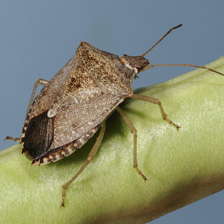
STINK BUGS: attack tomatoes, okra, Southern peas, beans, and corn.
Several different species of stink bugs occur in Mississippi vegetable gardens. Adults of these brown or green, shield-shaped insects are about three-eighths of an inch long. The immatures (nymphs) are similar in shape but are wingless and, depending on the species, may be solid tan or green with white and pink spots or horizontal stripes. Both stages cause damage by feeding on fruit (tomatoes, okra pods, and pea or bean seeds) with their piercing-sucking mouthparts. The barrel-shaped eggs are attached to the leaves in clusters. Curled, distorted okra pods are often the result of stink bug feeding. Tomatoes develop white or yellow corky spots underneath the skin as a result of stink bug feeding. Depending on the size of the seed when attacked, pea and bean seeds may shrivel or have sunken, stung spots. This damage is often confused with that caused by cowpea curculios. Heavy infestations of stink bugs can seriously damage tomatoes, beans, and peas. Stink bugs also feed on corn and can kill seedling plants or curl ears. Although it is not uncommon to see individual examples of these two types of damage, it is uncommon for many plants or ears to be damaged this way. Stink bugs often build to high numbers on agricultural crops and other alternate hosts and move to gardens in late summer and fall.
Management Practices: Plant peas, beans, and tomatoes early to avoid the high numbers of stink bugs common in late summer and fall. Hand-picking egg masses, nymphs, and adults can help slow population buildup in small plantings.
Control: pyrethrins*, bifenthrin, malathion, permethrin, cyhalothrin, zetamethrin
You may have to spray several times to control the heavy infestations that often invade gardens in late summer and fall.
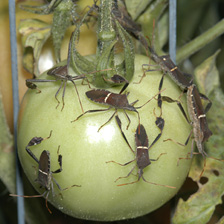
LEAF-FOOTED BUGS: attack tomatoes and other vegetables.
Although leaf-footed bugs feed on many other vegetables, they are mainly a problem on tomatoes, peppers, and tomatillos. They feed with piercing-sucking mouthparts. These insects are similar to stink bugs but are larger and longer (about five-eighths of an inch long). Adults are grayish-brown with a distinct white stripe across the back. Their most distinctive trait is their flattened, leaf-shaped hind legs. These insects are often mistakenly identified as squash bugs, but squash bugs do not have the leaf-shaped hind legs or the white line across the back. Adults often attack tomatoes and peppers in high numbers in late summer and early fall. Leaf-footed bugs tend to fly and leave the plants when disturbed, but they return after the disturbance has passed. This habit makes leaf-footed bugs especially difficult to control with foliar sprays.
Management Practices: Early planting can help avoid the high numbers of leaf-footed bugs that are common in late summer and fall. Sunflowers can be used as a “trap crop.” Heavy numbers often congregate on developing sunflower blooms, where you can kill them with contact sprays. Such treatments work best when applied early in the morning, when insects are less likely to fly. If you don’t treat them, though, sunflowers can serve as a nursery crop, resulting in higher populations of leaf-footed bugs.
Control: pyrethrins*, malathion, bifenthrin, permethrin, cyhalothrin, zetamethrin
You must spray adult leaf-footed bugs directly to have control. This can be difficult because of the insect’s habit of flying away when disturbed. Apply sprays early in the morning when insects are cooler and less likely to fly.
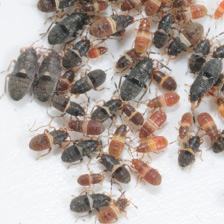
CHINCH BUGS: attack corn.
Adult chinch bugs are about one-fifth of an inch or less long and are black with white wings folded in an X over their backs. The immature chinch bug, or nymph, is red or black with a light band across the back. Seedling corn plants less than 6 inches tall can be seriously injured or killed by this pest. Both adults and nymphs feed with piercing-sucking mouthparts, and the saliva they inject into the plant while feeding causes toxic reactions. Damaged seedlings will be curled or stunted. Seedlings damaged to this degree do not produce viable plants. It takes only four or five chinch bugs to seriously injure plants less than 6 inches tall. Larger plants can tolerate higher infestations, and it is not uncommon to see mature plants infested with several hundred chinch bugs but suffering little apparent damage.
Management Practices: Water seedling corn well. Drought conditions favor chinch bug population development and make seedlings more susceptible to injury. Check emerging corn seedlings regularly until they are at least 6 inches tall and are growing vigorously, and treat promptly if you detect chinch bugs. On seedling corn, chinch bugs can be found at or below ground level, within the whorl, and under leaf sheaths.
Control: malathion, bifenthrin, permethrin, cyhalothrin, zetamethrin
Be sure to use enough spray volume when treating for chinch bugs. Direct sprays toward the bases of the plants and into leaf whorls. Most chinch bugs will be slightly belowground, in cracks near the plants, and between the plant and soil.
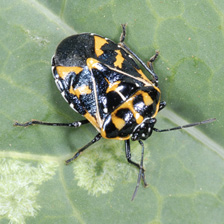
HARLEQUIN BUGS: attack collards, cabbage, broccoli, cauliflower, mustard, turnips, other brassicas, and occasionally other vegetables.
Harlequin bugs look very much like stink bugs. The adults are strikingly marked in black and yellow, or red. Nymphs are similarly colored but have horizontal bands across their backs. The barrel-shaped eggs, which have two distinctive black bands, are deposited in clusters on the leaves. Unlike stink bugs, harlequin bugs are active throughout the winter, as well as in late fall and early spring, but they hibernate through the summer. Harlequin bugs are mainly found on cruciferous plants, especially collards and cabbage. Both adults and nymphs feed on the leaves and leaf buds with their piercing-sucking mouthparts, causing white, sunken spots or blotches at the point of feeding. Heavy infestations can cause deformed plant growth and wilting.
Management Practices: Destroy stands of brassica plants as soon as they stop producing. This prevents harlequin bugs from continuing to reproduce on abandoned plants. Hand-picking eggs, nymphs, and adults can benefit small plantings.
Control: malathion, bifenthrin, permethrin, zetamethrin
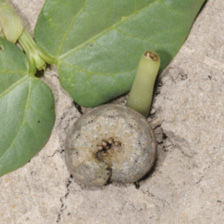
CUTWORMS: attack young transplants and newly emerged seedlings.
Cutworms are caterpillar pests that cut the stem of young transplants and newly emerged seedlings. There are several species, many of which begin feeding on weedy vegetation in late summer and fall and overwinter in the soil as partially grown larvae. Because transplants are more costly and are planted at lower densities, the potential for serious damage is higher for the transplants than for direct seeded plants. As plants grow larger, they become less susceptible to cutworm injury.
Management Practices: Tilling the garden at least 3 weeks before seeding and transplanting starves many overwintered larvae. Wrapping the lower stem area of transplants with strips of paper or aluminum foil, a “cutworm collar,” will protect transplants from cutworm feeding.
Control: permethrin, bifenthrin, carbaryl, malathion, zetamethrin
In high-risk situations, spray newly set transplants and the soil immediately surrounding them with permethrin.
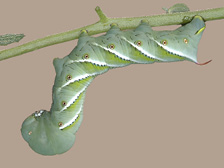
TOBACCO HORNWORMS AND TOMATO HORNWORMS: attack tomatoes and occasionally peppers or eggplant.
The distinctive horn on the rear of the body makes this large, green caterpillar easy to identify. The species most commonly seen on tomatoes in Mississippi is the tobacco hornworm, which usually has a reddish horn and seven white diagonal stripes on the side. The tomato hornworm usually has a black or green horn and white V-shaped marks on the side. Mature larvae may reach 4 inches in length, and caterpillars of this size can quickly consume large amounts of leaf area. Occasionally these caterpillars feed on fruit, but defoliation is the major type of injury. You rarely see the large, gray, night-flying moths. These jet-shaped moths lay their large, shiny eggs individually on the leaves of host plants.
Management Practices: Hand-picking eggs and caterpillars can help in small plantings.
Control: Bt kurstaki*, spinosad*, malathion, permethrin, bifenthrin, cyhalothrin, zetamethrin
Spray if you see caterpillars or defoliation.
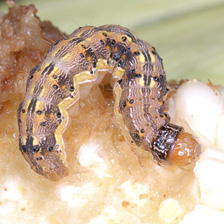
TOMATO FRUITWORMS/CORN EARWORMS: attack tomatoes, tomatillos, corn, and occasionally other vegetables.
These are the caterpillars so commonly encountered feeding in the ends of corn ears, and they can ruin an otherwise beautiful tomato. They also occasionally occur in other vegetables, such as eggplant, okra, beans, and peas, but seldom in high numbers. Tomato fruitworms are especially damaging to tomatoes and tomatillos. These robust caterpillars vary from green or light yellow to brown or black. Mature larvae are about 11⁄2 inch long. The night-flying moths are light brown with one somewhat indistinct spot in the center of each forewing. They lay small, round eggs individually on the silks of corn or on the bloom clusters of tomatoes. Newly deposited eggs are white but become darker as they mature. Caterpillars bore into fruit. In corn, the damage is usually restricted to the first 1 or 2 inches of kernels at the tip of the ear, but when the larvae bore into tomatoes, the entire fruit is usually lost. Immature, marble-sized fruit may be damaged, as well as large, mature fruit.
Management Practices: There are several generations per year, and numbers increase with each generation, so early crops normally have lower infestations than late-summer and fall crops. Because of the high number of spray applications required to control this pest in corn, most home gardeners choose to do nothing and simply discard the damaged portion of the ear at harvest. Tomatoes are a different matter! Heavy infestations of tomato fruitworms can destroy more than 50 percent of a tomato crop if not controlled.
Control: Bt kurstaki*, spinosad*, permethrin, bifenthrin, cyhalothrin, zetamethrin
Corn can be partially protected by spraying with a recommended insecticide at 3- to 5-day intervals, beginning at first silk. Begin treating tomatoes after they begin to bloom and set fruit. Spray at 7- to 10-day intervals. Most of the recommended insecticides can be tank-mixed with tomato fungicides, but check the labels of both products before tank-mixing. Large caterpillars that have bored into fruit are difficult to control. The goal is to control small, newly hatched caterpillars before they have a chance to cause damage.
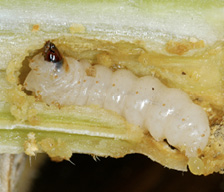
SQUASH VINE BORERS: attack squash, pumpkins, and other cucurbits.
This is the insect that causes large squash and pumpkin plants to wilt suddenly and die. It occasionally attacks other cucurbits. The adult is a reddish-orange, day-flying moth with black wings. Moths are often mistaken for paper wasps, which they resemble. The moths lay their eggs on leaves and leaf petioles. The larvae bore into the plant as soon as they hatch. The caterpillars then make their way toward the base of the plant, feeding and growing as they go. Feeding by small larvae causes little noticeable damage, but by the time they have reached the base of the plant and are longer than 1 inch, the larvae are eating lots of plant material. It is this girdling effect that causes plants to wilt suddenly and die. Mature larvae leave the plant and tunnel into the soil before spinning cocoons.
Management Practices: Plant early to avoid the much heavier populations that occur in late season. Some types of squash are less susceptible than others. Yellow summer squash is highly preferred, but zucchini is less commonly attacked. Some types of pumpkins (C. mixta) and winter squash (C. moschata) are also less susceptible than others. Promptly destroying plants after final harvest, or plants that have died, prevents many insects from completing development.
Control: permethrin, bifenthrin, acetamiprid, zetamethrin
It takes repeated insecticide sprays and thorough coverage to control squash vine borers with insecticides. You must control newly hatched larvae before they bore into the plant. Be sure to spray the vines and base of the plant adequately, as well as leaf petioles and the undersides of leaves.
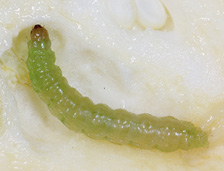
PICKLEWORMS: attack squash, pumpkins, cucumbers, and melons.
Because pickleworms do not overwinter in Mississippi, they are mainly late-season pests. The small larvae initially feed on blooms, but large larvae often bore into fruit, creating small entrance holes plugged with frass. These entrance holes often go unnoticed when fruit is harvested, resulting in fruit that rots while in storage. Squash and pumpkins are especially favored hosts. Melonworm is a closely related species that first feeds on leaves of cucurbits but also bores into fruit, similar to the pickleworm. On cantaloupe, these pests usually feed on and scar the surface of the rind rather than boring into the fruit.
Management Practices: Plant early to avoid heavy populations of pickleworms and melonworms. Fall squash and pumpkins are the crops most likely to be infested with these pests.
Control: permethrin, bifenthrin, zetamethrin
Insecticide sprays targeting squash vine borers also control pickleworms and melonworms.
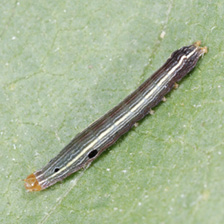
ARMYWORMS: attack corn and other vegetables.
Several species of armyworms occur in the home vegetable garden. These include beet armyworms, yellowstriped armyworms, Southern armyworms, and fall armyworms. Armyworms are robust caterpillars approximately 11⁄2 inch long when mature. Except for the fall armyworm, the bodies of these caterpillars are smooth and hairless. The fall armyworm appears slick-bodied, but close examination reveals a few stiff hairs on the body. Armyworms are mainly leaf-feeders, but some species occasionally damage fruit.
Fall armyworms are particularly a problem on late-planted corn, causing damage by feeding in the whorls of pre-tasseling plants or by chewing into the sides of ears on more mature plants. Yellowstriped armyworms are present in early spring and often cause minor defoliation damage to seedling tomatoes, okra, beans, and other plants. Occasionally, yellowstriped armyworm larvae also feed directly on fruit. Because armyworm moths lay their eggs in large clusters, you often see large numbers of caterpillars on one plant or in a small area of the garden.
Management Practices: Plant corn early to avoid heavy populations of fall armyworms in late season. Row covers can help prevent moths from laying eggs on young plants. Hand-picking egg masses can also be helpful, but most egg masses are on the undersides of leaves where they are difficult to detect.
Control: spinosad*, Bt kurstaki*, permethrin
Carbaryl or permethrin can be effective against very small, newly hatched caterpillars, but spinosad is more effective against larger caterpillars. Bts are generally less effective against armyworms than against other caterpillar pests. When treating whorl stage corn, be sure to direct sprays into the whorl.
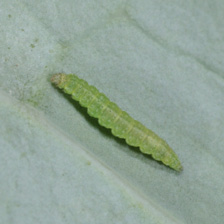
DIAMONDBACK MOTHS: attack collards, cabbage, broccoli, and other brassicas.
Mature specimens of this small, green caterpillar are less than one-half of an inch long, but they are still significant pests of collards, cabbage, and other brassicas. The caterpillars tend to be very active when handled, often wiggling violently and/or flipping off the plant. The small, silken cocoons are attached to the undersides of leaves or in the heads of broccoli or cauliflower. The moths are only about one-fourth of an inch long and are gray with a tan border down the middle of the back that often looks like a row of overlapping diamond shapes. Heavy infestations can cause severe defoliation. Plants that are severely defoliated in the seedling stage may fail to form proper heads. Collards and cabbage are the most preferred hosts. This pest may be present year-round, especially in the southern portions of the state.
Management Practices: Avoid unnecessary insecticide use, which can disrupt beneficial insects.
Control: spinosad*, Bt kurstaki*
The diamondback moth is resistant to many insecticides, including Bts. Avoid repetitive use of any single active ingredient. Use enough spray to get thorough coverage, and be sure to cover undersides of leaves.
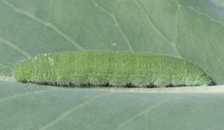
IMPORTED CABBAGEWORMS: attack cabbage, collards, broccoli, and other brassicas.
Imported cabbageworm caterpillars are green with yellow markings, and their skin has a velvety texture. Mature larvae are slightly longer than 1 inch. The adult butterflies have a wingspan of about 2 inches. The wings are white on top with black tips and a few black spots, but the undersides are pale yellow. These caterpillars eat the leaves and bore into the heads of mature plants. Even low populations can cause fecal contamination. Severe defoliation can kill young plants or interfere with proper head formation, and heavy infestations can destroy large plants. This insect is most common during the cooler parts of the year, which is when most cole crops are grown. Several other related caterpillar species also occur on brassica plants.
Management Practices: Row covers can help prevent butterflies from laying eggs on young plants.
Control: spinosad*, Bt kurstaki* Check newly transplanted plants frequently, and treat at first signs of caterpillar infestation.

CROSS-STRIPED CABBAGEWORMS: attack cabbage, collards, turnips, bok choy, and other brassicas.
Cross-striped cabbageworms are easily identified by the alternating black and white stripes that run across their backs and the yellow line that runs along their sides. Mature caterpillars are about three-fourths of an inch long. Caterpillars damage plants by chewing holes in leaves and by contaminating plants with their fecal material and bodies. Caterpillars leave the plants and burrow into the soil to pupate.
Management Practices: Row covers can help prevent moths from laying eggs on plants.
Control: spinosad*, B.t. kurstaki*
Check plants regularly, and spray as needed.
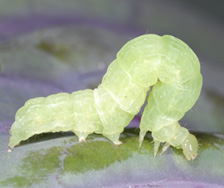
LOOPERS: attack cabbage, collards, broccoli, other brassicas, and other vegetables.
Several species of loopers occur in the home vegetable garden, but the cabbage looper is the most common. Loopers have fewer prolegs than other caterpillars, and they move in a looping, inchworm-like manner. Cabbage looper larvae are pale green with a white stripe down their sides, and mature larvae are about 11⁄2 inch long. These caterpillars often rest by grasping the leaf with the prolegs, located near the rear of the body, and holding the head and true legs away from the leaf surface. Damage is from defoliation and fecal contamination. Cabbage and other brassicas are the primary crops cabbage loopers attack, but they can damage other vegetables, such as lettuce, tomatoes, and watermelons. Newly hatched caterpillars often feed on the bottom side of the leaf, leaving the transparent upper epidermis intact. This creates a windowpane effect, and these windowpane areas can be an early warning of looper infestations. The night-flying moths have gray wings with a silver, figure-eight-shaped spot in the center of each forewing.
Management Practices: Row covers can help prevent the moths from laying eggs on young plants.
Control: spinosad*, Bt kurstaki*
Check newly transplanted plants frequently, and treat at first signs of caterpillar infestation.

WIREWORMS: damage roots of seedling plants; also damage Irish potatoes and sweet potatoes.
Wireworms are primarily a problem in new gardens planted on sites where pastures, lawns, or other grasses were recently growing. They are the larvae of click beetles. Wireworms have tough, shiny, brown, segmented bodies and cause damage by feeding on roots and boring into roots, tubers, and stems. They are rarely a serious problem on established, well-kept garden sites.
Management Practices: Avoid planting on sites where established pasture or grasses have been recently growing. If possible, use tillage or herbicides to kill grasses growing on new garden sites several months before planting. Till garden site several weeks before planting.
Control: bifenthrin
Apply bifenthrin granules (Monterey Vegetable Garden Soil Insecticide or Ortho BugClear Lawn Insect Killer) according to label directions just before planting or shortly after plants emerge. Incorporate into the top 4 to 6 inches of soil.
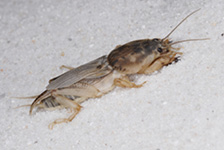
MOLE CRICKETS: damage roots of seedling plants.
Mole crickets are common pests of lawns and turf in the southern half of the state. These insects tunnel just under the surface of the soil, leaving trails that resemble miniature mole tunnels. They occasionally cause damage in South Mississippi gardens, especially on sites with sandy soil. Damage occurs when large numbers of nymphs tunnel through soil, destroying roots with their tunneling activity and their feeding on roots of young plants. Mole crickets have only one generation per year and overwinter as partly grown nymphs. Most damage is caused by overwintered nymphs as they feed actively in the spring in preparation for adulthood. Mole cricket nymphs usually invade garden sites from surrounding lawns and turf.
Management Practices: Till the garden site several weeks before planting. Proactively control mole crickets in turf areas immediately surrounding the garden. See MSU Extension Publication 2331 Control Insect Pests in and Around the Home Lawn for information on mole cricket control in turf and proper timing for mole cricket treatments. Do not apply insecticides directly to the garden site unless the label specifically allows application around garden vegetables.
Control: bifenthrin
Apply bifenthrin granules (Monterey Vegetable Garden Soil Insecticide or Ortho BugClear Lawn Insect Killer) according to label directions just before planting or shortly after plants emerge. Incorporate into the top 4 to 6 inches of soil.
Insecticides for Home Vegetable Gardens
This section provides general information about some of the more common insecticides labeled for use in the home vegetable garden. See the table below for insecticide recommendations for specific pests.
Use insecticides safely! Before using any insecticide, always read the label carefully, and follow all directions for personal protection equipment and instructions for mixing and applying the product. The label is the law, and the use directions it specifies are for the safety of the applicator, the environment, and those using the area. Handle insecticides with the respect they deserve. They are poisons, and excessive exposure can result in acute and/or chronic health problems.
Be sure the insecticide is labeled for use on the vegetable being treated. Few insecticides are labeled for use on every vegetable crop grown in the garden. Before applying an insecticide to a particular crop, be sure to read the label and verify that the product is labeled for use on that crop.
Observe the pre-harvest interval. The pre-harvest interval, or PHI, is how much time must pass between making an insecticide application and harvesting the crop. PHIs vary greatly, depending on the insecticide you’re using and the vegetable crop you’re treating. For example, the PHI for bifenthrin is 1 day for tomatoes, 7 days for okra, and 21 days for sweet potatoes.
Observe the re-entry interval. The re-entry interval is how much time must pass between making an insecticide application and re-entering the area without protective equipment to do work such as weeding, pruning, or staking.
Specific Insecticides
Insecticides marked with an asterisk (*) are suitable for organic gardening.
Malathion— an older garden insecticide that has largely been displaced by newer, more effective products. However, it is especially useful for control of aphids. Malathion also controls most “bugs” and beetle pests. Ortho Malathion Insect Spray Concentrate and Bonide Malathion Insect Control are two examples.
Bt kurstaki*— Bacillus thuringiensis is a bacterium that produces compounds toxic to certain insect species. Different species and strains of this bacterium produce different toxins. Bt kurstaki produces a compound that is toxic to caterpillars but has no effect on other insect species. Thuricide and Monterey B.t. are two of the more common brand names under which this product is sold. It is most effective against leaf-feeding caterpillars, such as loopers and diamondback moths.
Spinosad*— a relatively new microbial insecticide that is very effective against most caterpillar pests. Two commonly available brand names labeled for use on many different vegetable crops are Monterey Garden Insect Spray and Fertilome Bore, Bagworm, Leafminer, and Tent Caterpillar Spray. Spinosad is effective against most caterpillar pests, but it is not effective against most other types of insects. It is effective against thrips, leaf miners, and Colorado potato beetles. Certain formulations of spinosad are acceptable for use by organic gardeners. Ferti-lome Come & Get It Fire Ant Killer is a granular fire ant bait that contains spinosad and is labeled for use in vegetable gardens.
Acetamiprid— especially effective against whiteflies and aphids and labeled for control of many other pests. Ortho Max Flower Fruit and Vegetable Insect Killer is one common brand name. It is only available as a ready-to-use spray.
Imidacloprid— a soil-applied systemic insecticide that is especially useful against whiteflies, aphids, and cucumber beetles. It is applied as a soil drench shortly after transplanting or seedling emergence. Do not make more than one application per year, and do not harvest within 21 days after application. BioAdvanced Fruit, Citrus, & Vegetable Insect Control is a common brand name that is labeled for use on many vegetables.
Insecticidal Soap*— (or potassium salts of fatty acids) control the insects they contact by disrupting cell membranes. They are most effective against soft-bodied pests, such as aphids, mites, and thrips. Thorough coverage of the pest is necessary to achieve control. Insecticidal soaps have a short preharvest interval and are labeled for use on most vegetables. Safer Brand Insect Killing Soap is an example of one brand name.
Neem Oil*— a botanical product useful primarily against aphids, mites, and whiteflies. Neem oil is labeled for use on most vegetables and is sold under several brand names (Monterey 70% Neem Oil is one example). Thorough coverage of the pest is necessary for control.
Azadirachtin*— an organic product labeled for use on all vegetables, with a zero-day PHI. Azatrol is the brand name most often used by home gardeners, but several other commercial formulations are available. Azadirachtin has activity against a wide range of insect pests but is most useful against soft-bodied sucking pests, like whiteflies and aphids. Although azadirachtin and neem oil both come from the seed of the neem tree, they are not the same product.
Pyrethrin*— (or pyrethrum) a botanical insecticide used primarily by organic gardeners. Pyrethrin provides rapid knockdown of most insects, but insects often recover. Piperonyl butoxide (PBO) is often mixed with pyrethrin to act as a synergist. It increases the overall effectiveness and helps prevent pests from recovering, but PBO is not acceptable for organic gardening. Pyrethrin or pyrethrin + PBO is active against a wide range of insects, is labeled for use on most vegetables, and has a very short pre-harvest interval, but its efficacy is limited by its very short residual activity. Pyganic Gardening 1.4 EC is one example of a pyrethrin product that does not contain PBO. Bonide Pyrethrin Garden Insect Spray Concentrate is an example of a pyrethrin product synergized with PBO.
Pyrethroids— a group of relatively new synthetic insecticides modeled after the botanical pyrethrum molecule. Pyrethroids are effective against a wide range of insect pests and are used at very low rates. The following pyrethroid insecticides are currently labeled for use in the home vegetable garden.
Permethrin: the oldest and most common of the pyrethroid insecticides. Permethrin is widely available and is sold under many different brand names (Martin’s Vegetables Plus; Bonide Eight Insect Control Concentrate; and Hi-Yield Garden, Pet, & Livestock Insect Control are three examples). Permethrin is labeled for use on many different vegetable crops and is effective against many beetle, bug, and caterpillar pests.
Cyhalothrin: Lambda cyhalothrin (Spectracide Triazicide Insect Killer for Lawns and Landscapes is the most common brand name) is effective against a number of different insect pests, but it is labeled for use on only a few vegetable crops.
Zeta cypermethrin/zetamethrin: only recently labeled for use in home vegetable gardens, as GardenTech Sevin Insect Killer Concentrate. This will create considerable confusion because Sevin has traditionally contained the active ingredient carbaryl, and many formulations of Sevin that contain carbaryl are still being sold. Zetamethrin is an especially useful insecticide for home vegetable gardens because it is labeled for use on most vegetables with a 1-day preharvest interval and is effective against most insect pests, but check the label carefully for exceptions. Some crops have significantly longer preharvest intervals, and this and other pyrethroids do not control some pests, such as aphids, spider mites, whiteflies, and certain caterpillar pests.
Cyfluthrin: effective against a wide range of insect pests. BioAdvanced Vegetable & Garden Insect Spray is an example of one brand name product. This product is not labeled for use on all vegetable crops, and preharvest intervals vary considerably.
Bifenthrin + zeta-cypermethrin: premix of two different pyrethroids, sold as Ortho Bug B Gon Insect Killer for Lawns & Gardens Concentrate. Bifenthrin is an especially useful pyrethroid for crops on which it is labeled, but it is not labeled on all vegetable crops. Bifenthrin is less likely than most other pyrethroids to trigger outbreaks of aphids or spider mites.
Applying Insecticides in the Home Vegetable Garden
There are several different methods of applying insecticides to vegetables in the home garden. Dusts, ready-to-use sprays, and liquid sprays are three of the most common.
Dusts
A few insecticides are available as ready-to-use dust formulations (5% Sevin Dust and 0.25% permethrin are two examples). You usually apply dusts with a shaker can or a hand-powered, pump-type duster. Often the container the insecticide comes in is modified for use as a shaker can. Dusts are convenient to apply, but generally they don’t work as well as sprays. It is also difficult to get thorough, uniform coverage with dusts, especially when you use the shaker can method of application. Also, many people consider dusts to be unsightly.
Ready-to-Use Sprays
Several insecticides are sold as ready-to-use (RTU) sprays labeled for the home garden. Permethrin, carbaryl, cyhalothrin, cyfluthrin, and neem oil are examples of active ingredients sold as RTUs. They come in trigger-pump spray bottles in which the product has already been diluted to its final use strength. They are convenient for applying spot treatments to individual plants, but they are too costly and time-consuming to use on a large scale.
Single-Nozzle Hand-Pump Sprayers
Single-nozzle hand-pump sprayers are the most common way to apply insecticides in the home garden. They range in capacity from 1 quart to 5 gallons, with 1 gallon being the most common size. You can apply liquid concentrate, wettable powder, or wettable granule insecticides according to label directions. Here is an example of the directions that might appear on the label of a liquid concentrate: “Mix 1 tablespoon/gallon of water and spray to run-off, taking care to direct spray to undersides of leaves.”
Hand-pump sprayers are powered by pumping air into the headspace over the insecticide mixture. This compressed air then forces the insecticide spray through the nozzle when the spray valve is opened. Most hand sprayers have an adjustable nozzle you can use to adjust how coarse or fine the spray droplets are. Be sure to rinse the sprayer thoroughly after each use. To avoid injuring crops, do not apply insecticides with a sprayer that was previously used to apply herbicide. It is best to have one sprayer specifically for herbicide use and another for applying insecticides and fungicides. Label each sprayer clearly.
Always carefully read and follow the insecticide label.
Insecticides for Insect Control in Home Vegetable Gardens
Insecticides are listed by active ingredient. See the section “Specific Insecticides” on pages 15 and 16 for examples of brand name products that contain these active ingredients and more detailed information about active ingredients.
*(PHI): Pre-harvest interval. The numbers in parentheses indicate the pre-harvest interval, or the number of days that must elapse between treatment and harvest. Always verify PHIs from the label of the insecticide being used.
|
Crop |
Pest |
Insecticide (PHI)* |
|---|---|---|
|
Beans (lima beans, snap beans, pole beans) |
Aphids |
azadirachtin (0), malathion (1), insecticidal soap (1), neem oil (NA), acetamiprid (7) |
|
Spider mites |
insecticidal soap (1), neem oil (NA) |
|
|
Bean leaf beetles Cucumber beetles Mexican bean beetles |
bifenthrin (3), malathion (3), zetamethrin (1) |
|
|
Cowpea curculios |
bifenthrin (3), zetamethrin (1) |
|
|
Corn earworms Lima bean pod borers Other caterpillars |
bifenthrin (3), spinosad (3), zetamethrin (1) |
|
|
Leaf miners |
spinosad (3) |
|
|
Stink bugs Plant bugs |
malathion (1), bifenthrin (3), pyrethrins (0), zetamethrin (1) |
|
|
Broccoli, Cauliflower |
Aphids |
acetamiprid (7), malathion (broccoli = 3; cauliflower = 7), insecticidal soap (1), neem oil (NA) |
|
Loopers Diamondback moths Other caterpillars |
Bt kurstaki (0), spinosad (1) |
|
|
Harlequin bugs Stink bugs |
cyhalothrin (1), malathion (broccoli = 3; cauliflower = 7), bifenthrin (7), permethrin (1), zetamethrin (1) |
|
|
Brussels Sprouts |
Aphids |
acetamiprid (7), malathion (7), insecticidal soap (1), neem oil (NA) |
|
Loopers Diamondback moths Other caterpillars |
Bt kurstaki (0), spinosad (1) |
|
|
Harlequin bugs Stink bugs |
cyhalothrin (1), malathion (7), permethrin (1), zetamethrin (1) |
|
|
Cabbage |
Aphids Thrips |
acetamiprid (7), malathion (7), insecticidal soap (1), neem oil (NA) |
|
Loopers Diamondback moths Cabbageworms |
Bt kurstaki (0), spinosad (1) |
|
|
Harlequin bugs Stink bugs |
cyhalothrin (1), malathion (7), permethrin (1), bifenthrin (3), zetamethrin (1) |
|
|
Collards |
Aphids |
malathion (7), insecticidal soap (1), neem oil (NA), acetamiprid (7) |
|
Loopers Diamondback moths |
Bt kurstaki (0), spinosad (1) |
|
|
Harlequin bugs Stink bugs |
malathion (7), zetamethrin (1) |
|
|
Corn |
Cutworms |
bifenthrin (1), cyhalothrin (21), permethrin (1), zetamethrin (3) |
|
Chinch bugs Stink bugs |
bifenthrin (1), cyhalothrin (21), esfenvalerate (1), malathion (5), permethrin (1), zetamethrin (3) |
|
|
Corn earworms Fall armyworms European corn borers |
bifenthrin (1), cyhalothrin (21), malathion (5), permethrin (1), pyrethrins (0), spinosad (1), zetamethrin (3) |
|
|
Cucumbers |
Thrips |
permethrin (1), spinosad (3), bifenthrin (3), zetamethrin (1) |
|
Cucumber beetles Flea beetles |
permethrin (1), bifenthrin (3), malathion (1), zetamethrin (1) |
|
|
Leafminers |
spinosad (3) |
|
|
Loopers |
spinosad (3), Bt kurstaki (0) |
|
|
Pickleworms Melonworms |
permethrin (1), bifenthrin (3), spinosad (3), zetamethrin (1) |
|
|
Whiteflies |
azadirachtin (0), insecticidal soap (1), neem oil (NA) |
|
|
Spider mites |
malathion (1), insecticidal soap (1), neem oil (NA) |
|
|
Eggplant |
Flea beetles |
malathion (3), bifenthrin (7), permethrin (3), zetamethrin (1) |
|
Colorado potato beetles Tortoise beetles |
spinosad (1), permethrin (3), bifenthrin (7), acetamiprid (7), zetamethrin (1) |
|
|
Irish Potatoes |
Colorado potato beetles |
spinosad (7), permethrin (7), acetamiprid (7), zetamethrin (1) |
|
Blister beetles Flea beetles |
permethrin (7), zetamethrin (1) |
|
|
Potato tuberworms |
permethrin (7), zetamethrin (1) |
|
|
Leaf miners |
spinosad (7) |
|
|
Lettuce |
Aphids |
malathion (head lettuce = 7; leaf lettuce = 14), insecticidal soap (1), neem oil (NA) |
|
Caterpillars |
Bt kurstaki (0), spinosad (1), permethrin (1), cyhalothrin (1), zetamethrin (1) |
|
|
Melons |
Thrips |
permethrin (1), spinosad (3), bifenthrin (3), zetamethrin (1) |
|
Cucumber beetles Flea beetles |
permethrin (1), bifenthrin (3), malathion (1), zetamethrin (1) |
|
|
Leafminers |
spinosad (3) |
|
|
Loopers |
spinosad (3), Bt kurstaki (0) |
|
|
Pickleworms Melonworms |
permethrin (1), bifenthrin (3), spinosad (3), zetamethrin (1) |
|
|
Whiteflies |
azadirachtin (0), insecticidal soap (1), neem oil (NA) |
|
|
Spider mites |
malathion (1), insecticidal soap (1), neem oil (NA) |
|
|
Mustard |
Aphids |
malathion (7), insecticidal soap (1), neem oil (NA) |
|
Loopers Diamondback moths |
Bt kurstaki (0), spinosad (1) |
|
|
Vegetable weevils Yellow-margined leaf beetles |
malathion (7), zetamethrin (1) |
|
|
Okra |
Aphids |
azadirachtin (0), acetamiprid (7), insecticidal soap (1), neem oil (NA), malathion (1) |
|
Stink bugs Leaffooted bugs |
malathion (1), pyrethrins (0), bifenthrin (7), zetamethrin (1) |
|
|
Corn earworms |
spinosad (1), bifenthrin (7), zetamethrin (1) |
|
|
Loopers Other caterpillars |
Bt kurstaki (0), spinosad (1) |
|
|
Onions |
Onion thrips |
malathion (3), cyhalothrin (14), insecticidal soap (1), spinosad (1) |
|
Peas, Southern (cowpeas, field peas, black-eyed peas, crowder peas) |
Aphids |
azadirachtin (0), malathion (3), insecticidal soap (1), neem oil (NA), acetamiprid (7) |
|
Spider mites |
malathion (3), insecticidal soap (1), neem oil (NA) |
|
|
Bean leaf beetles Cucumber beetles Mexican bean beetles |
malathion (3), bifenthrin (3), zetamethrin (1) |
|
|
Cowpea curculios |
bifenthrin (3), zetamethrin (1) |
|
|
Corn earworms Lima bean pod borers Other caterpillars |
spinosad (3), bifenthrin (3), zetamethrin (1) |
|
|
Stink bugs Plant bugs |
malathion (3), pyrethrins (0), bifenthrin (3), zetamethrin (1) |
|
|
Peas, Sweet/English (English peas, sweet peas, snow peas) |
Aphids |
azadirachtin (0), malathion (3), insecticidal soap (1), neem oil (NA), acetamiprid (7) |
|
Thrips |
malathion (3), spinosad (3) |
|
|
Caterpillar pests |
spinosad (3), Bt kurstaki (0) |
|
|
Leaf miners |
spinosad (3) |
|
|
Peppers |
Aphids |
azadirachtin (0), acetamiprid (7), insecticidal soap (1), neem oil (NA), malathion (1), pyrethrins (0) |
|
Leafminers |
spinosad (1) |
|
|
Flea beetles |
permethrin (3), zetamethrin (1) |
|
|
European corn borers |
cyfluthrin (7), permethrin (3), spinosad (1), zetamethrin (1) |
|
|
Thrips |
malathion (3), permethrin (3), spinosad (1) |
|
|
Spider mites |
malathion (3), insecticidal soap (1), neem oil (NA) |
|
|
Pepper weevils |
malathion (3), permethrin (3), zetamethrin (1) |
|
|
Spinach |
Aphids |
malathion (7), insecticidal soap (1), neem oil (NA) |
|
Leafminers |
spinosad (1) |
|
|
Loopers Other caterpillars |
Bt kurstaki (0), spinosad (1) |
|
|
Squash, Pumpkin |
Squash bugs |
bifenthrin (3), malathion (squash = 1; pumpkin = 3), permethrin (1), pyrethrins (0), insecticidal soap (1), acetamiprid (0), zetamethrin (1) |
|
Squash vine borers |
bifenthrin (3), permethrin (1), acetamiprid (0), zetamethrin (1) |
|
|
Pickleworms |
bifenthrin (3), permethrin (1), malathion (squash = 1; pumpkin = 3), zetamethrin (1) |
|
|
Cucumber beetles |
bifenthrin (3), permethrin (1), malathion (squash = 1; pumpkin = 3), acetamiprid (0), zetamethrin (1) |
|
|
Spider mites |
insecticidal soap (1), neem oil (NA) |
|
|
Sweet Potatoes |
Armyworms Loopers |
spinosad (7) |
|
Flea beetles Cucumber beetles Tortoise beetles |
permethrin (7), zetamethrin (1) |
|
|
Sweet potato weevils |
bifenthrin (21) |
|
|
Tomatoes |
Tomato fruitworms Tomato hornworms |
Bt kurstaki (0), bifenthrin (1), cyhalothrin (5), zetamethrin (1), malathion (1), permethrin (1), pyrethrins (0), spinosad (1) |
|
Loopers |
Bt kurstaki (0), spinosad (1) |
|
|
Stink bugs Leaffooted bugs |
bifenthrin (1), malathion (1), cyhalothrin (5), permethrin (1), pyrethrins (0), zetamethrin (1) |
|
|
Spider mites |
insecticidal soap (1), neem oil (NA) |
|
|
Thrips |
bifenthrin (1), cyhalothrin (5), malathion (1), permethrin (1), pyrethrins (0), spinosad (1), zetamethrin (1) |
|
|
Whiteflies |
azadirachtin (0), acetamiprid (7), insecticidal soap (1), neem oil (NA), insecticidal oil |
|
|
Leafminers |
spinosad (1) |
|
|
Aphids |
azadirachtin (0), acetamiprid (7), insecticidal soap (1), neem oil (NA), malathion (1), pyrethrins (0) |
|
|
Turnips |
Aphids |
azadirachtin (0), malathion (7), insecticidal soap (1), neem oil (NA) |
|
Vegetable weevils Yellow-margined leaf beetles Flea beetles |
malathion (7), zetamethrin (1) |
|
|
Loopers Diamondback moths |
Bt kurstaki (0), spinosad (1) |
Photo Credits
Mexican bean beetles photo credit (Frank Peairs, Colorado State University, bugwood.org)
Sweet potato weevil adult photo credit (Florida Division of Plant Industry, bugwood.org)
Imported cabbageworm caterpillar photo credit (Russ Ottens, University of Georgia, bugwood.org)
The information given here is for educational purposes only. References to commercial products, trade names, or suppliers are made with the understanding that no endorsement is implied and that no discrimination against other products or suppliers is intended.
This work is partially supported by Crop Protection and Pest Management, Extension Implementation Program grant no. 2017-70006-27200/project accession no. 1014037 from the USDA National Institute of Food and Agriculture. Any opinions, findings, conclusions, or recommendations expressed in this publication are those of the author(s) and do not necessarily reflect the view of the U.S. Department of Agriculture.
Publication 2347 (POD-01-23)
By Blake Layton, PhD, Extension Professor, Entomology.
The Mississippi State University Extension Service is working to ensure all web content is accessible to all users. If you need assistance accessing any of our content, please email the webteam or call 662-325-2262.
